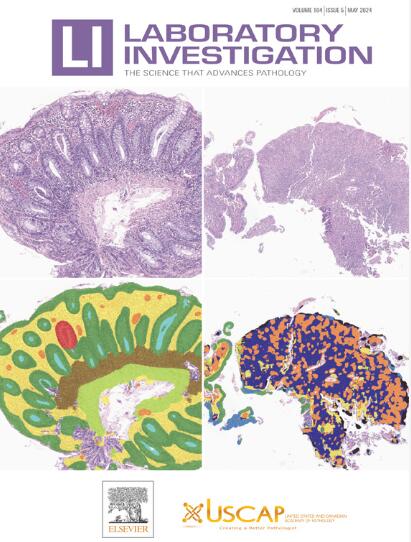Comprehensive Analysis of N6-Methyladenosine (m6A) RNA Methylation Regulators in Soft Tissue Leiomyosarcoma
IF 4.2
2区 医学
Q1 MEDICINE, RESEARCH & EXPERIMENTAL
引用次数: 0
Abstract
N6-methyladenosine (m6A), a widespread RNA modification, plays a vital role in various biological processes, including carcinogenesis, tumor progression, and immune regulation. We conducted this study to investigate the relationship between m6A regulators, such as METTL3, METTL14, WTAP, FTO, ALKBH5, and YTHDF1-3, and their association with c-Myc and programmed death ligand 1 (PD-L1) expression in leiomyosarcoma (LMS). The expression of these epitranscriptome regulator genes was evaluated using the next-generation sequencing data of 53 patients with LMS obtained from an online public database. We next determined the relationship between m6A regulators and c-Myc and CD274 (PD-L1) mRNA expression in an LMS cell line. We also performed immunohistochemical staining of 69 LMS cases. Immunohistochemical staining showed that cases with higher expression of METTL3, METTL14, ALKBH5, FTO, and WTAP exhibited higher c-Myc expression, and cases with higher expression of ALKBH5, YTHDF2, and WTAP exhibited higher mitotic activity. Gene set enrichment analysis revealed that METTL3, METTL14, and FTO knockdown significantly suppressed c-Myc target gene expression. Knockdown of METTL3, ALKBH5, YTHDF1, WTAP, and FTO in LMS cell lines reduced cell proliferation. These results suggest the relationship between m6A modifications and c-Myc-driven oncogenesis. Moreover, knockdown of YTHDF2 inhibited interferon gamma–induced PD-L1 expression, suggesting its role in immune evasion through PD-L1 regulation. Multivariate Cox proportional hazards analysis revealed that lower YTHDF2 expression and higher WTAP expression are unfavorable prognostic factors. These findings provide potential therapeutic targets for LMS, particularly in combination with immune checkpoint inhibitors. Further investigation into the molecular mechanisms of m6A-mediated regulation of PD-L1 and c-Myc expression is required to develop more effective treatments for LMS.
软组织平滑肌肉瘤中m6A RNA甲基化调控因子的综合分析。
n6 -甲基腺苷(m6A)是一种广泛存在的RNA修饰,在多种生物过程中起着至关重要的作用,包括致癌、肿瘤进展和免疫调节。本研究旨在探讨m6A调节因子(如METTL3、METTL14、WTAP、FTO、ALKBH5和YTHDF1-3)与平滑肌肉瘤(LMS)中c-Myc和程序性死亡配体1 (PD-L1)表达的关系。使用从在线公共数据库获得的53例LMS患者的下一代测序数据来评估这些表转录组调控基因的表达。接下来,我们确定了m6A调节因子与LMS细胞系中c-Myc和CD274(PD-L1) mRNA表达之间的关系。我们还对69例LMS患者进行了免疫组化染色(IHC)。免疫组化染色显示,METTL3、METTL14、ALKBH5、FTO和WTAP高表达的患者c-Myc表达较高,ALKBH5、YTHDF2和WTAP高表达的患者有丝分裂活性较高。基因集富集分析(GSEA)显示,METTL3、METTL14和FTO敲低可显著抑制c-Myc靶基因的表达。在LMS细胞系中,METTL3、ALKBH5、YTHDF1、WTAP和FTO的表达下调可降低细胞增殖。这些结果表明m6A修饰与c- myc驱动的肿瘤发生之间存在关系。此外,敲低YTHDF2可抑制干扰素-γ诱导的PD-L1表达,提示其通过调节PD-L1参与免疫逃避。多因素Cox比例风险分析显示,低表达的YTHDF2和高表达的WTAP是不利的预后因素。这些发现为LMS提供了潜在的治疗靶点,特别是与免疫检查点抑制剂联合使用。需要进一步研究m6a介导的PD-L1和c-Myc表达调控的分子机制,以开发更有效的LMS治疗方法。
本文章由计算机程序翻译,如有差异,请以英文原文为准。
求助全文
约1分钟内获得全文
求助全文
来源期刊

Laboratory Investigation
医学-病理学
CiteScore
8.30
自引率
0.00%
发文量
125
审稿时长
2 months
期刊介绍:
Laboratory Investigation is an international journal owned by the United States and Canadian Academy of Pathology. Laboratory Investigation offers prompt publication of high-quality original research in all biomedical disciplines relating to the understanding of human disease and the application of new methods to the diagnosis of disease. Both human and experimental studies are welcome.
 求助内容:
求助内容: 应助结果提醒方式:
应助结果提醒方式:


